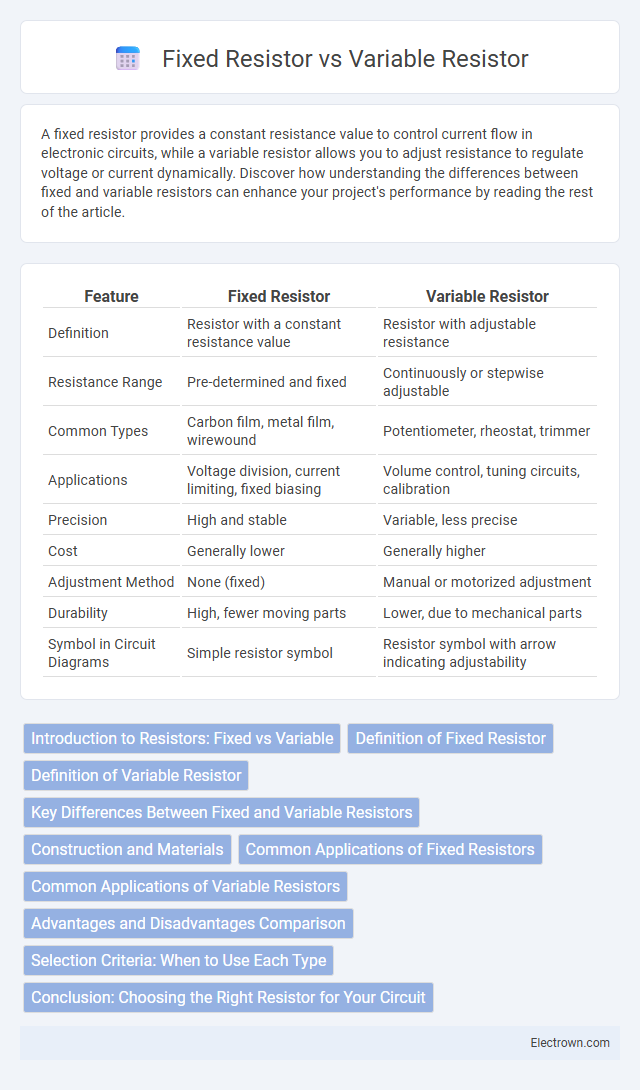A fixed resistor provides a constant resistance value to control current flow in electronic circuits, while a variable resistor allows you to adjust resistance to regulate voltage or current dynamically. Discover how understanding the differences between fixed and variable resistors can enhance your project's performance by reading the rest of the article.
Table of Comparison
| Feature | Fixed Resistor | Variable Resistor |
|---|---|---|
| Definition | Resistor with a constant resistance value | Resistor with adjustable resistance |
| Resistance Range | Pre-determined and fixed | Continuously or stepwise adjustable |
| Common Types | Carbon film, metal film, wirewound | Potentiometer, rheostat, trimmer |
| Applications | Voltage division, current limiting, fixed biasing | Volume control, tuning circuits, calibration |
| Precision | High and stable | Variable, less precise |
| Cost | Generally lower | Generally higher |
| Adjustment Method | None (fixed) | Manual or motorized adjustment |
| Durability | High, fewer moving parts | Lower, due to mechanical parts |
| Symbol in Circuit Diagrams | Simple resistor symbol | Resistor symbol with arrow indicating adjustability |
Introduction to Resistors: Fixed vs Variable
Fixed resistors provide a constant resistance value useful for stable circuit conditions, while variable resistors offer adjustable resistance to control current flow dynamically. Fixed resistors are commonly available in standard values and power ratings, such as 1 kO or 10 kO with 0.25W ratings, ensuring consistent performance. Variable resistors, including potentiometers and rheostats, allow fine-tuning of voltage or current, essential for calibration and user-controlled devices.
Definition of Fixed Resistor
A fixed resistor is an electronic component that provides a constant resistance value, limiting the flow of electric current in a circuit with precision. Unlike variable resistors, fixed resistors cannot be adjusted after manufacturing, ensuring stable and predictable performance in electronic devices. Your circuit design relies on fixed resistors for consistent voltage regulation and current control.
Definition of Variable Resistor
A variable resistor, also known as a potentiometer or rheostat, is an electronic component that allows the resistance value to be adjusted manually within a specific range. Unlike a fixed resistor, which provides a constant resistance, a variable resistor enables fine-tuning of current flow and voltage levels in a circuit. Your ability to control resistance with a variable resistor makes it essential for applications like volume control, light dimming, and calibration.
Key Differences Between Fixed and Variable Resistors
Fixed resistors have a constant resistance value that cannot be altered once manufactured, commonly used for precise current control and voltage division. Variable resistors, such as potentiometers and rheostats, allow manual adjustment of resistance to control circuit parameters dynamically. The key difference lies in the fixed resistor's stability and predictability versus the variable resistor's flexibility for tuning and calibration in electronic circuits.
Construction and Materials
Fixed resistors are typically constructed with a solid core made from materials such as carbon film, metal oxide, or wire-wound elements encased in a protective insulating material, offering precise, stable resistance values. Variable resistors, also known as potentiometers or rheostats, feature a resistive track made from carbon, cermet, or conductive plastic and a movable wiper that adjusts the resistance by sliding along the track. Your choice between fixed and variable resistors depends on whether you need a constant resistance or the ability to fine-tune electrical properties in your circuit.
Common Applications of Fixed Resistors
Fixed resistors are commonly used in electronic circuits for current limiting, voltage division, and signal conditioning due to their precise resistance values. They appear in power supplies, electronic amplifiers, and LED circuits where stable resistance is crucial for maintaining consistent performance. Their reliability in controlling current and voltage makes them essential components in consumer electronics, automotive systems, and industrial machinery.
Common Applications of Variable Resistors
Variable resistors are widely used in applications requiring adjustable control of electrical current, such as volume knobs in audio equipment and light dimmers in household lighting systems. They also play a crucial role in calibration circuits and sensor tuning, allowing precise adjustments to electrical parameters for optimal device performance. Your ability to fine-tune resistance values makes variable resistors essential in testing and prototyping environments.
Advantages and Disadvantages Comparison
Fixed resistors offer stable resistance values, ensuring consistent electrical performance and easy circuit design, with the advantages of lower cost and higher reliability, but lack flexibility in adjusting resistance during operation. Variable resistors provide adjustable resistance, allowing fine-tuning of circuit parameters, ideal for applications requiring calibration or response changes, yet they tend to have higher complexity, potential wear over time, and increased cost. Choosing between fixed and variable resistors depends on the need for stability versus adaptability in the specific electrical application.
Selection Criteria: When to Use Each Type
Fixed resistors are ideal for applications requiring consistent resistance values, such as setting bias currents or voltage dividers, ensuring stable and predictable circuit performance. Variable resistors, including potentiometers and rheostats, are selected when adjustable resistance is needed for calibration, tuning, or controlling parameters like volume or brightness. Your choice depends on whether precision and stability or flexibility and customization are critical to your electronic design.
Conclusion: Choosing the Right Resistor for Your Circuit
Selecting the appropriate resistor depends on the circuit requirements and desired control over resistance values. Fixed resistors provide stable, precise resistance ideal for consistent current limiting, while variable resistors (potentiometers) allow adjustable resistance for tuning and calibration. Understanding the specific application ensures optimal performance by balancing stability and flexibility in electrical circuits.
fixed resistor vs variable resistor Infographic

 electrown.com
electrown.com